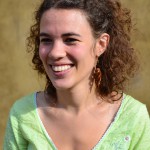 Maëlle Drouillat – ACTeon Project Manager – Leading the Agricultural Project: Water and Environmental Management
Maëlle Drouillat – ACTeon Project Manager – Leading the Agricultural Project: Water and Environmental Management
Ever since I was little, I’ve loved nature, and this passion for Life Sciences led me to study to be an Agronomist at AgroParisTech. Discovering agronomy, coupled with my environmental awareness, were the key factors in determining what I wanted to do later, and led me to decide to specialise in Environmental Management Engineering. And today that has allowed me to have the all the bases to work in a transversal way on subjects related to the environment, agronomy, biodiversity, water management, and so on. Thanks to my missions in the ACTeon research and development department, based in Colmar, I help support, develop and roll out environmental projects or strategies.
So what does your mission in the LIFE ALISTER Project consist in?
I’ve been working on the LIFE ALISTER Project since 2013, with ACTeon. Our role is to assess the environmental and economic impact of actions put in place by all our partners.
My main mission consists in highlighting the relevance of actions undertaken to protect the European Hamster, and consequently, other animals living in agricultural fields. For this, I work closely with Julie Roux, from GEPMA. This assessment also measures stakeholder buy-in to change behaviours or habits (general public, and farmers, etc.).
Results of this study will be published when the project has been wound up, and they’ll be able to be used as a guide for Alsatians, as well as all Europeans who are concerned about the European Hamster, so that they’ll be able to put in place the best solutions for the preservation of this animal!
I also have a mission where I carry out a survey on knowledge and perception of the European Hamster in Alsace, for the population here.
What does that consist in?
The goal is to measure the knowledge and interest people have in biodiversity, the European Hamster and preservation actions undertaken in this project, in what Alsatians consider as their Alsatian “landscape.” We wrote a questionnaire which allows us to have a portrait of the current situation, at the beginning of the project. We have just finished, and nearly 600 Alsatians responded. Similarly, in 2017, when this project will be wound up, we’ll question the Alsatians once again in order to assess any eventual impact the project had on knowledge and perceptions of the European Hamster: did their interest for these questions change?
Before this study goes public, can you tell us about one particular element that either really interested or astonished you?
For example, it was interesting to find out that nearly 3/4 of Alsatians already were familiar with the European Hamster and the survival issues this species has. These Alsatians value the animal much more than those who had never heard of it. That goes to show the importance of communication on the hamster and the work we’re doing.
What do you like about this project?
There are loads of things. Being able to find solutions for a species, here it’s the European Hamster, without forgetting all the economic questions and how people see the hamster, is something that’s really interesting. Also, understanding the various reflection mechanisms that Alsatians have about the European Hamster, in order to better communicate, is something that seems important to me. And last but not least, the fact that I work (and we’ve got a great atmosphere!) with different types of profiles on the same question is really enriching and pleasant.

